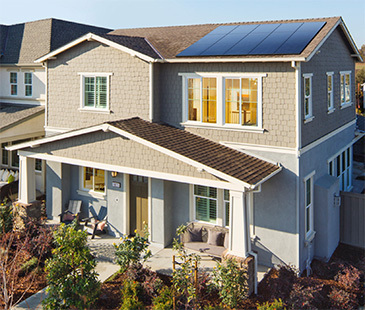
Editor’s Note: In 2020, SunPower announced the completion of the strategic spin-off of its manufacturing division into a separate business named Maxeon Solar Technologies, Ltd. As a result, SunPower has expanded its offerings to drive future growth. The SunPower Equinox® system now offers multiple panel options, including front- and back-contact panels, all of which are responsibly and rigorously quality tested to provide the best energy solution for your home. For more information on the differences in panel technology, see: http://ow.ly/5hPL50LzjxK.
When the world-famous San Francisco Exploratorium was preparing to move to a new location in 2013, its leadership team had a vision of building a net zero facility.
The interactive museum of science, art and human perception partnered with SunPower to design and install a 1.3 megawatt rooftop solar system on a historic waterfront building using 5,874 high-efficiency SunPower® solar panels.
Today the SunPower system generates about 80 percent of the electric power used by the green museum and is critical to minimizing its environmental impact on the San Francisco Bay Area. The money saved is being invested in creating more innovative educational experiences, and the solar installation helps teach the more than 1 million annual visitors about clean energy.
Watch this video for more on this amazing solar project.
Finding the right solar solution to power the museum was crucial to the Exploratorium for two reasons: fulfilling its educational mission and reducing its environmental impact. The organization also required durable solar technology built to last and reliably perform over the long-term.
“Our goal is to make the biggest impact through our mission, while ensuring the least impact possible on the environment,” says Laura Zander, Exploratorium Chief Operating Officer.
Zander points out they have a 66-year lease on the property.
"Our solution needed to be able to stand up to not only the test of time but also the foggy, salty air,” she says.
And, by reducing energy costs, the museum can better fulfill its mission of creating inquiry-based experiences that transform learning, says Shani Krevsky, Campus Project Director.
“We're keeping that money focused on newer and better exhibits that benefit every visitor who walks through our doors,” Krevsky says.
Becoming a Platinum LEED-Certified Building
The 330,000-square-foot indoor/outdoor campus is three times larger than the museum’s original location at the Palace of Fine Arts. Although the new space is enormous, featuring six main galleries, a 200-seat theater, a life sciences laboratory and classrooms and labs, the museum was still able to earn a LEED Platinum certification by meeting stringent U.S. Green Building Council requirements.
In addition to solar, the Exploratorium demonstrates its commitment to sustainability at every opportunity, from using San Francisco Bay water to radiantly heat and cool the buildings, to collecting rainwater to flush toilets, to using a combination of LED, fluorescent and induction lighting to keep the facility bright and energy efficient.
The Exploratorium features an exhibit that educates and inspires multiple generations about the importance of sustainability. As one of the greenest museums in the world, the Exploratorium has made solar energy a centerpiece of its sustainability efforts.

